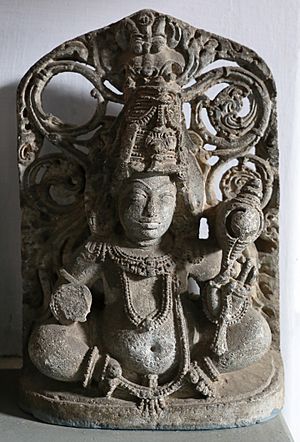Kakatiya dynasty facts for kids
Quick facts for kids
Kakatiya dynasty
|
|||||||||||||||||||
|---|---|---|---|---|---|---|---|---|---|---|---|---|---|---|---|---|---|---|---|
| 1163–1323 | |||||||||||||||||||
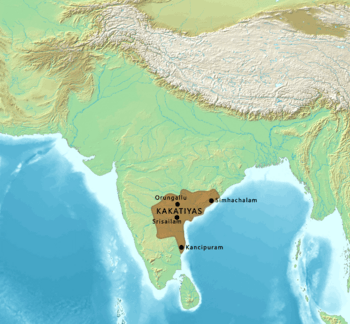
Map of the Kakatiyas, circa 1150-1300 CE.
|
|||||||||||||||||||
| Status | Empire (Subordinate to Western Chalukyas until 1163) |
||||||||||||||||||
| Capital | Orugallu (Warangal) | ||||||||||||||||||
| Common languages | Telugu, Sanskrit, Kannada | ||||||||||||||||||
| Religion | Hinduism (Converted from Jainism) | ||||||||||||||||||
| Government | Monarchy | ||||||||||||||||||
| King | |||||||||||||||||||
| History | |||||||||||||||||||
|
• Earliest rulers
|
c. 800 | ||||||||||||||||||
|
• Established
|
1163 | ||||||||||||||||||
|
• Disestablished
|
1323 | ||||||||||||||||||
|
|||||||||||||||||||
| Today part of | India | ||||||||||||||||||
The Kakatiya dynasty was an important Indian kingdom. It ruled over much of eastern Deccan from the 12th to the 14th centuries. This area includes parts of modern-day Telangana, Andhra Pradesh, Karnataka, and Odisha. Their capital city was Orugallu, which is now known as Warangal.
For over 200 years, early Kakatiya rulers were like helpers to bigger empires. These included the Rashtrakutas and Western Chalukyas. In 1163 CE, a ruler named Prataparudra I became fully independent. He took control by defeating other local chiefs.
Later, King Ganapati Deva (who ruled from 1199–1262) made the Kakatiya kingdom much bigger. He added the fertile lands around the Godavari and Krishna rivers. After him, his daughter Rudrama Devi (who ruled from 1262–1289) became queen. She was one of the few female rulers in Indian history. The famous traveler Marco Polo even wrote about her strong and wise rule. She successfully defended her kingdom from attacks by the Yadavas.
In 1303, the Delhi Sultanate, led by Alauddin Khilji, tried to invade the Kakatiya lands. This first attack was a big failure for them. However, after a long siege in 1310, King Prataparudra II had to agree to pay yearly taxes to Delhi. Another attack in 1323 by Ulugh Khan finally defeated the Kakatiya army. After their fall, the region faced a time of confusion. But soon, the Musunuri Nayaks united different Telugu groups. They took back Warangal from the Delhi Sultanate.
The Kakatiyas helped bring together different cultures in the Telugu-speaking lands. This created a stronger sense of shared identity among people who spoke Telugu. They also built many "tanks" or reservoirs for irrigation in the dry uplands. Many of these are still used today. The Kakatiyas were fair and allowed anyone, regardless of their birth, to become a nayaka (a warrior leader). They even let farmers join the army, which helped people move up in society. The Kakatiya period also saw a unique style of architecture. Famous examples include the Thousand Pillar Temple, Ramappa Temple, Warangal Fort, and Kota Gullu.
Contents
What's in a Name?
Historians like Dineshchandra Sircar have studied old writings and coins. They found that the family name was spelled in different ways. Some spellings were Kakatiya, Kakatiyya, Kakita, Kakati, and Kakatya. Sometimes, the family name was put before the ruler's name, like Kakatiya-Prataparudra.
The dynasty's name comes from the word "Kakati." This might have been the name of a goddess or a place. It's possible that Kakati was a goddess worshipped by the early Kakatiya chiefs. It could also be the name of the place where they lived.
Some old writings say the dynasty was named after Kakati, a form of the goddess Durga. While Hindu stories don't mention this form of Durga, other sources do. For example, a 15th-century text mentions an image of Kakatamma (Mother Kakati) in the capital city of Orugallu. Another writing from the 16th century talks about rebuilding a statue of the goddess Jaganmatruka. This statue had been destroyed by the Turkic people. Some historians think Kakati was originally a Jain goddess, perhaps Padmavati. Later, she might have been seen as a form of Durga.
An inscription from the time of Ganapati-deva says the family's founder was Venna. It states he lived at Kakati, which is why his family was called Kakatishas. The exact location of Kakati is not known today.
Family Background
The Kakatiya rulers said they came from a legendary chief named Durjaya. Many other ruling families in the Andhra region also claimed to be related to Durjaya. We don't know much more about this chief.
Most Kakatiya records don't mention their social class (varna). But the ones that do, proudly say they were Shudra. This means they were not from the traditional warrior or priestly classes. They also married into other Shudra families. This shows that the Kakatiyas likely came from a Shudra background.
A few copper plate writings describe them as belonging to the Kshatriya (warrior) class. These writings were usually for giving land to Brahmins. They might have been influenced by the stories of the powerful Cholas. For example, one writing connects the Kakatiyas to ancient warrior kings like Rama. The term "Kshatriya" in these records probably meant they were brave warriors, not necessarily their actual birth class.
Some evidence suggests the Kakatiyas were originally from the Rashtrakuta family. This family was from the Kannada region. A gold coin from Queen Rudramadevi even shows Kannada writing. This suggests a connection to the Kannada-speaking areas.
Early Rulers
The exact years when the early Kakatiya chiefs ruled are not fully known. Venna is the first known chief. After him came Gunda I, Gunda II, and Gunda III. Gunda III was followed by Erra, who ruled areas near Warangal. Erra's successor, Gunda IV (around 955-995 CE), was known for defeating his enemies.
Gunda IV was followed by Beta I (around 996-1051). Then came Prola I (around 1052-1076), who was called "lion to the elephant-like enemies." Other chiefs included Beta II (c. 1076–1108), Tribhuvanamalla Durgaraja (c. 1108–1116), and Prola II (c. 1116–1157).
Early Kakatiya rulers used the title "Reddi," which means "king" in Telugu. But once they became independent rulers, they used "deva" (Lord) and "devi" (Lady). This change shows they became more like traditional kings.
Connection to the Rashtrakutas
It seems that early Kakatiya family members were military leaders for the Rashtrakutas. An inscription from 956 CE mentions a Kakatiya chief named Gundyana. He was a general for the Rashtrakuta king Krishna III. This suggests a strong link between the two families.
The Kakatiyas seemed to use the mythical bird Garuda as their royal symbol. Garuda is the vehicle of the god Vishnu. The Rashtrakutas also used Garuda as their symbol. This supports the idea that the Kakatiyas might have been connected to the Rashtrakuta family. Some historians also think the early Kakatiya chiefs followed Jainism, which the Rashtrakutas also supported.
After the Rashtrakuta power declined, the Kakatiyas served the Kalyani Chalukyas. When the Chalukya power also weakened in the 12th century, the Kakatiyas became fully independent.
Independent Rulers
Prataparudra I
The Kakatiyas became a fully independent power in 1163. This happened during the rule of Prataparudra I. He was also known as Rudra Deva. He ruled from about 1158 to 1195. His father, Prola II, had tried to expand Kakatiya influence. Prola II died in a battle around 1157.
Prataparudra I built the Thousand Pillar Temple in Hanumakonda, their capital at the time. This temple was a symbol of their new independent status. From this time on, their inscriptions were written in Telugu language instead of Kannada.
Mahadeva became king after Prataparudra I. He ruled from about 1195 to 1199.
Ganapati Deva
King Ganapati Deva ruled from 1199 to 1262. He greatly expanded the Kakatiya kingdom. In the 1230s, he launched attacks outside his family's traditional area. He brought the Telugu-speaking delta lands around the Godavari and Krishna rivers under his control. This helped unite the different regions.
Ganapati also worked to make the capital city, Orugallu, stronger. He built a huge granite wall around the city. It had ramps, a moat, and many strong towers. He also wanted to improve the kingdom's economy. He encouraged merchants to trade with other countries. He removed most taxes, only keeping a small fee. He also created the man-made Pakhal Lake.
Rudrama Devi
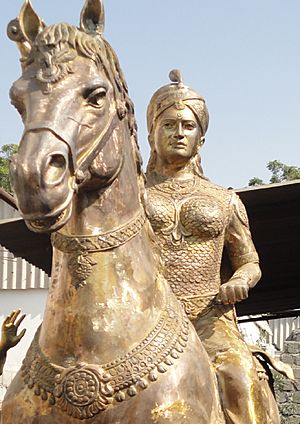
Rudrama Devi was a queen who ruled from about 1262 to 1289 CE. She is one of the few female rulers in Indian history. She continued to strengthen the capital city. She made Ganapati's wall even taller and added another earthen wall with a wide moat.
The famous traveler Marco Polo visited India around 1289–1293. He wrote good things about Rudrama Devi's rule. She successfully fought off attacks from the Yadava army. Rudrama Devi was married to Virabhadra, a prince from the Eastern Chalukyas. She had no son to take over the throne. So, she made her grandson her heir. This happened as the powerful Delhi Sultanate began to threaten the Deccan region.
Prataparudra II
Prataparudra II was Rudrama Devi's grandson. He became king in 1289 and ruled until the dynasty ended in 1323. His reign marked a big change in the Deccan region. Kingdoms started to become larger sultanates.
The End of the Kakatiyas
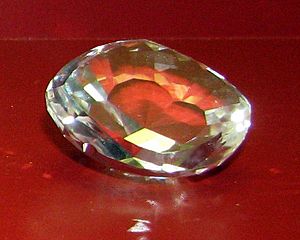
The Kakatiya kingdom was very rich, which caught the eye of the Delhi Sultanate ruler Alauddin Khalji. In 1303, Alauddin's first attack on the Kakatiya kingdom failed. The Kakatiya army fought bravely and defeated them.
But in 1309, Alauddin sent his general, Malik Kafur, to attack again. After a month-long siege of Orugallu, the Kakatiyas were defeated in February 1310. King Prataparudra II had to accept being under the Delhi Sultanate. He had to pay yearly taxes to Delhi. It was likely at this time that the famous Koh-i-Noor diamond went from the Kakatiyas to Alauddin. They also gave 20,000 horses and 100 elephants.
In 1311, Prataparudra helped the Sultanate army attack the Pandyan empire. He used this chance to control some of his own local rulers who wanted independence. However, in 1318, he failed to pay the yearly tax to Delhi. Alauddin's son, Mubarak Shah, sent another general, Khusrau Khan, to Orugallu. This army had new weapons like catapults. Prataparudra had to surrender again. He had to publicly bow towards Delhi from the walls of Orugallu. His yearly tax was changed to 100 elephants and 12,000 horses.
These new rules didn't last long. In 1320, a new sultan, Ghiyasuddin Tughlaq, came to power in Delhi. Prataparudra again declared his independence. Tughlaq sent his son, Ulugh Khan, to defeat the Kakatiya king in 1321. This siege lasted six months because of problems within Khan's army. The attackers were pushed back at first. Prataparudra celebrated, giving out food to his people.
But Khan returned in 1323 with a stronger army. With few supplies left, Prataparudra was forced to surrender after another five-month siege. The Kakatiya army was defeated. Orugallu was renamed Sultanpur. It is believed that Prataparudra took his own life while being taken as a prisoner to Delhi.
Kingdom and Society
Geography
The Kakatiya kingdom started in Orugallu, in the dry uplands of northern Telangana. From there, they expanded their power to Coastal Andhra. This is the delta area between the Godavari and Krishna rivers. This region was home to many Brahmins, while the uplands had more farmers, artisans, and warriors. The Kakatiyas helped blend these two cultures. This created a shared feeling among people who spoke Telugu. This was a major achievement.
The Kakatiya kingdom was largest around the 13th century. At this time, four main Hindu kingdoms ruled South India. The Kakatiyas were one of them. They often fought with the other kingdoms. The Kakatiyas eventually controlled a large area. It stretched from near Anagondi in the west to Kalyani in the north-east, and down to parts of southern Odisha.
Architecture
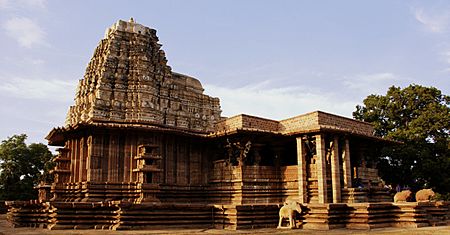
A big change during this time was the building of many reservoirs for irrigation. About 5,000 of these were built by warrior families under the Kakatiyas. This greatly helped farming in the dry areas. Many of these "tanks," like the large ones at Pakala and Ramappa, are still used today.
Temples were also important. In the populated delta areas, there were already large, rich Hindu temples. But in the uplands, smaller temples were built during the Kakatiya period. These upland temples were often linked to building and maintaining the reservoirs. This helped create political connections. Giving land for temples and attending worship helped strengthen the kingdom's structure. This was important as the farming society grew quickly.
Society
Old writings from the Kakatiya period show that society was very flexible. It was different from the strict caste system described in some ancient texts. Caste itself didn't seem to be the most important thing for social identity.
People could become a nayaka (a warrior leader) no matter where they were born. There is also little evidence that people were stuck in their jobs by birth. The population became more settled. Many nomadic tribal people became farmers.
The connection between politics and the military was strong. The Kakatiyas allowed farmers to join the army. This created a new warrior class and helped people improve their social standing. It also helped the dynasty spread its influence. The Kakatiya kings, especially the last two, encouraged everyone to be treated more equally. The power of the old noble families decreased. The kings gave land from nobles to people of lower status. This helped to weaken the old power structure.
Religion
Historians believe that the early Kakatiya chiefs followed Jainism. An old story says that an ancestor of the Kakatiyas gained military strength from the Jain goddess Padmakshi.
Later, King Prola II became a follower of Shaivism, a branch of Hinduism. He made Shaivism the family's main religion. The names of later Kakatiya kings, like Rudra and Ganapati, also show a shift towards Shaivism. This supports the idea that the early chiefs were Jains.
Family Tree
Here are some known members of the Kakatiya family. Rulers are children of their predecessors unless noted.
Early Chiefs
- Nripa Venna (ruled around 800-815)
- Gunda I (ruled around 815-?)
- Gunda II (ruled around ?-865)
- Gunda III (died before 900)
- Nripati Erra
- Betiya
- Nripati Gunda IV (ruled around 955-995)
- Nripati Beta I (ruled around 996-1051)
- Prola I (ruled around 1052-1076)
- Beta II (ruled around 1076-1108)
- Tribhuvanamalla Durgaraja (ruled around 1108-1116), son of Beta II
- Prola II (ruled around 1116-1157), son of Beta II. He married Muppama.
- His children included Rudra, Mahadeva, Harihara, Ganapati, and Repolla Durga.
Independent Rulers
- Rudra (ruled around 1158-1195), son of Prola II. He became independent in 1163.
- Mahadeva (ruled around 1196-1199), son of Prola II. He married Bayyama.
- Had three children: Ganapati-deva, Mailamba, and Kundamba.
- Ganapati-deva (ruled around 1199-1262). He married Somala-devi.
- Had two children: Ganapamba and Rudrama-devi.
- Rudrama-devi (ruled around 1262-1289). She married Chalukya Virabhadra.
- Had three children: Mummadamba, Rudrama, and Ruyyama.
- Prataparudra-deva (ruled around 1289-1323), son of Mummadamba. He sometimes paid taxes to the Delhi Sultanate.
What Happened Next
The Delhi Sultanate's control of the area lasted only about ten years. The fall of the Kakatiya dynasty caused a lot of chaos. Different groups resisted the Sultanate, and there were problems within the Sultanate itself. The Kakatiya kingdom broke apart. Its lands soon came under the control of many different families.
However, as early as 1330, the Musunuri Nayaks, who had been army chiefs for the Kakatiyas, united the Telugu groups. They took back Warangal from the Delhi Sultanate. They ruled for 50 years. Later, by the 15th century, these new kingdoms were taken over by the Bahamani Sultanate and the Sangama dynasty. The Sangama dynasty later became the powerful Vijayanagara empire.
A brother of Prataparudra II, Annamaraja, is linked to the ruling family of Bastar. This claim might be a way to make their rule seem more legitimate. It was common for new rulers to claim connections to older, powerful dynasties like the Kakatiyas.
Historians say that stories about Prataparudra II changed over time. People wanted to remember him as a good and strong king. One story from the 16th century even claimed he didn't die as a prisoner. It said he met the sultan, was seen as a god, and allowed to return home. Then, he supposedly told his warrior leaders to become independent kings. These stories helped give new ruling families a reason to be in power.


